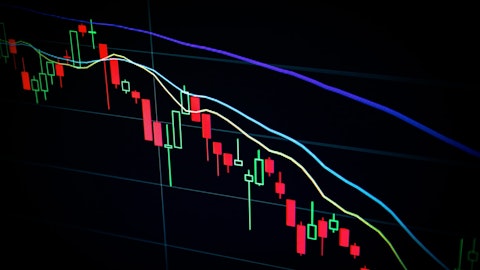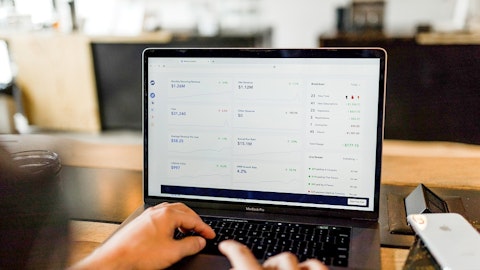Operator: Your next question comes from the line of George Staphos with Bank of America.
George Staphos: Hi, everyone. Good morning. Good afternoon. Thanks for taking my questions. I just want to make sure it’s two questions per or one question per. I don’t want to overdo the quota here.
Ron Delia: George, for you, it’s two.
George Staphos: Okay. I’ll try to keep them good then. So I guess the first thing I wanted to ask is, in an environment where we’re still to some degree waiting for customers, your customers, to begin promoting more aggressively to try volume, if you agree with that premise, are you starting to see that? And how does that reconcile with your wanting this to push more innovative new products, new product sustainability, which are typically going to have a higher price point? Who’s winning that tug of war right now as you think about it? And are we seeing more promotional activity?
Ron Delia: Look, it’s anecdotal at best, George. I mean, there’s, I think a general recognition across the customer base that the price lever has been pulled really hard. And you see that from the results of a range of consumer companies that price has been a real driver of revenue growth more so than volumes. And maybe that, maybe those two variables can be brought back into better balance over time. And you do hear anecdotally, more customers talking about reprioritizing volume or balancing their mix a little bit more towards volume. We need to see it, and we haven’t seen it yet. And so we’re not setting the business up on the expectation that happens. In fact, our second half earnings uplift that we’re expecting is not at all levered to an improved demand environment and is not at all predicated or dependent on consumers taking more active approach to promos.
George Staphos: Thanks Ron. And the second question, broadly, can you talk a little bit about the momentum you apparently are seeing in protein packaging? You have a new high barrier when that you highlight on one of the slides. You have your recycle ready ecotype package. Is there a way to put a quantum size? What kind of momentum you’re seeing? What kind of incremental revenue you’re getting and broadly why you are gaining this momentum in the market given that you’re the smaller player in the market. Thanks, and I’ll be back if there’s time later on.
Ron Delia: Okay. Look, I think it’s the early innings of our journey on protein, in particular our journey as a full service solutions provider in meat and protein packaging, which includes the ability to offer. equipment now as a result of the acquisition that we made earlier this year in Moda. It’s early innings. I think that we are picking up some modest pieces of business along the way, but I would also point out that meat sales have been weak. We’re in a down part, a down cycle, or a trough, let’s say, a low point of the cycle in beef in particular. And so meat sales have actually been weak across the company in the first quarter. It’s a long game, and we’re in the early innings. And so I would say that we’re really confident in the value proposition that we have and that we’re building.
We think we’ve got some really special films, and we think we’ve got a really special comprehensive offering that includes now equipment and service. But it’s very, very new, very recent. The Moda acquisition is only a few months old.
Operator: Your next question comes from the line of Sam Seow from Citi.
Sam Seow: Good morning, good evening, all. Thanks for taking my question. Just a simple one on the balance sheet. Just wondering if we guide, get back second half volume stabilization. Would that result in net debt outside your range or would there be enough in the seasonality and the unwinding of working capital to bring that debt irrespective of [inaudible] continued to decline?
Michael Casamento : Yes, thanks for the question, Sam. I can take that one. Yes, look, I mean, we finished the quarter with net debt kind of $6.5 billion $6.6 billion and leveraged at 3.3 times, which was right in line with where we expected it to be. And that takes into account the relatively normal seasonality of the cash flows from fourth quarter to Q1. We typically see a tick up in leverage versus we were at 3x in June. The other factors impacting leverage are really on — through temporary impacts. Firstly, we’re lapping now three quarters of the vested Russia earnings and that’s being reflected in the last 12-months EBITDA and that’s ahead of us getting the benefit of the restructuring which is going to start to come through in H2.
So you’ll start to see that improve absolutely. And then the other one is really the higher than normal working capital levels. We’ve been driving inventory down but at the same time payables have come down at a faster rate really just on the back of the lower demand environment. So again we’d expect that to start to normalize as we get into the second half and we’ll get the leverage back to 3x by the end of June. So that’s kind of the way we see it and as we look forward from there, there’ll be further opportunity for improvement particularly in the working capital as it continues to normalize and as we cycle through the full 12 months of the Russia and the benefits from the restructuring that we’re going to get into the P&L. So we’re on track there.
Sam Seow: Got it. And just maybe a follow-up. You talked at length about your volume expectations of the year. Maybe thoughts on pricing kind of expires through given end mark weakness and ongoing destocking.
Ron Delia: Well, look our pricing strategy has been first and foremost to compensate for inflation and that’s our approach, simple as that, we’ve had inflationary pressure on the cost base for 12 to 18 months now and as a result we’ve taken price as a high priority from an industry leadership perspective and certainly prioritized price and inflation recovery over volume. Rates of inflation are starting to ease. We haven’t seen large parts of the cost base go through experience decreases yet, but the rate of inflation has eased and so our pricing, the pace of our pricing will ease as a result and beyond that our pricing approach is really just a price for value. If we have a differentiated value proposition, there’s an opportunity to generate a positive price but that’s something that needs to be earned every day in the marketplace.
Operator: Your next question comes from the line of Mike Roxland with Truist Securities.




